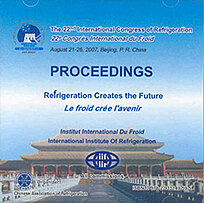
Document IIF
Aspects de l'amélioration de l'efficacité énergétique des pompes à chaleur et des systèmes frigorifiques à Bucarest en Roumanie.
Aspects regarding the energy efficiency increase in the case of refrigeration systems and heat pumps in Bucharest, Romania.
Auteurs : HERA D., ILIE A., DUMITRESCU R.
Résumé
This paper presents a theoretical study of a R-404A heat pump, designed to serve a residential building in Bucharest, by providing hot water for both the heating system and the domestic water system. This phreatic water driven heat pump has a heating capacity of 25 kW. Based on the experimental values provide by this heat pump, operated over the entire cold season 2005/2006, further design work was developed for an extended heating capacity of 118.5 kW demanded by a 24 apartment building consumer. Ecological reasons have brought into consideration ammonia instead of R-404A, first of them being the high total environment warming effect (TEWI) of R-404A. Consequently, a theoretical study was developed for an ammonia compression type heat pump, of the same total heating capacity (25 kW). The first approach showed unusually large vapour discharge temperatures, so the single stage system was replaced by a two-stage compression system. As compared to the R-404A heat pump, both ammonia heat pumps show higher COPs, that is COP1= 4.69, for the single-stage system and COP2= 5.5, for the two-stage system, vs. COP= 3.8.
Documents disponibles
Format PDF
Pages : ICR07-E2-390
Disponible
Prix public
20 €
Prix membre*
Gratuit
* meilleur tarif applicable selon le type d'adhésion (voir le détail des avantages des adhésions individuelles et collectives)
Détails
- Titre original : Aspects regarding the energy efficiency increase in the case of refrigeration systems and heat pumps in Bucharest, Romania.
- Identifiant de la fiche : 2008-0386
- Langues : Anglais
- Source : ICR 2007. Refrigeration Creates the Future. Proceedings of the 22nd IIR International Congress of Refrigeration.
- Date d'édition : 21/08/2007
Liens
Voir d'autres communications du même compte rendu (839)
Voir le compte rendu de la conférence
Indexation
-
Thèmes :
Pompes à chaleur à usage domestique;
Ammoniac;
Mélanges;
Efficacité energétique, économie d'énergie - Mots-clés : Système frigorifique; Comparaison; Ammoniac; R404A; Système biétage; Pompe à chaleur; Performance; Système monoétage; Immeuble d'habitation; Efficacité énergétique; Frigorigène; Chauffage urbain; Eau-eau
-
Energy Efficiency Research of an Air-source Hea...
- Auteurs : NI C., HUANG H., YANG L., WANG T.
- Date : 31/08/2021
- Langues : Anglais
- Source : 13th IEA Heat Pump Conference 2021: Heat Pumps – Mission for the Green World. Conference proceedings [full papers]
- Formats : PDF
Voir la fiche
-
Low temperature district heating based on low t...
- Auteurs : KNEPPER S., POTHOF I., ITARD L., FERREIRA C. I.
- Date : 31/08/2021
- Langues : Anglais
- Source : 13th IEA Heat Pump Conference 2021: Heat Pumps – Mission for the Green World. Conference proceedings [full papers]
- Formats : PDF
Voir la fiche
-
Load-Based Testing Methodology for Evaluating A...
- Auteurs : DHILLON P., HORTON W. T., BRAUN J. E.
- Date : 31/08/2021
- Langues : Anglais
- Source : 13th IEA Heat Pump Conference 2021: Heat Pumps – Mission for the Green World. Conference proceedings [full papers]
- Formats : PDF
Voir la fiche
-
Technical and economic analysis of a residentia...
- Auteurs : JORQUERA FERRAT P., MONDOT M.
- Date : 24/05/2021
- Langues : Anglais
- Source : 2021 Purdue Conferences. 6th International High Performance Buildings Conference at Purdue.
- Formats : PDF
Voir la fiche
-
A method for increasing the energy efficiency o...
- Auteurs : STENE J.
- Date : 17/09/2002
- Langues : Anglais
- Formats : PDF
Voir la fiche
